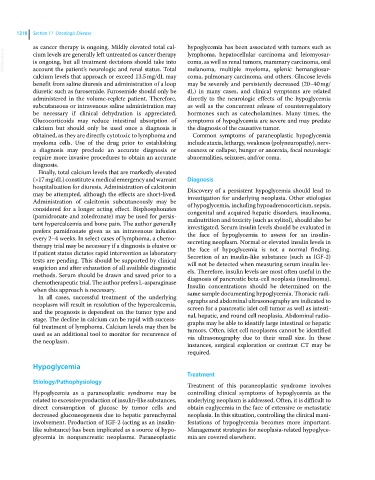Page 1280 - Clinical Small Animal Internal Medicine
P. 1280
1218 Section 11 Oncologic Disease
as cancer therapy is ongoing. Mildly elevated total cal- hypoglycemia has been associated with tumors such as
VetBooks.ir cium levels are generally left untreated as cancer therapy lymphoma, hepatocellular carcinoma and leiomyosar-
coma, as well as renal tumors, mammary carcinoma, oral
is ongoing, but all treatment decisions should take into
account the patient’s neurologic and renal status. Total
coma, pulmonary carcinoma, and others. Glucose levels
calcium levels that approach or exceed 13.5 mg/dL may melanoma, multiple myeloma, splenic hemangiosar-
benefit from saline diuresis and administration of a loop may be severely and persistently decreased (20–40 mg/
diuretic such as furosemide. Furosemide should only be dL) in many cases, and clinical symptoms are related
administered in the volume‐replete patient. Therefore, directly to the neurologic effects of the hypoglycemia
subcutaneous or intravenous saline administration may as well as the concurrent release of counterregulatory
be necessary if clinical dehydration is appreciated. hormones such as catecholamines. Many times, the
Glucocorticoids may reduce intestinal absorption of symptoms of hypoglycemia are severe and may predate
calcium but should only be used once a diagnosis is the diagnosis of the causative tumor.
obtained, as they are directly cytotoxic to lymphoma and Common symptoms of paraneoplastic hypoglycemia
myeloma cells. Use of the drug prior to establishing include ataxia, lethargy, weakness (polyneuropathy), nerv-
a diagnosis may preclude an accurate diagnosis or ousness or collapse, hunger or anorexia, focal neurologic
require more invasive procedures to obtain an accurate abnormalities, seizures, and/or coma.
diagnosis.
Finally, total calcium levels that are markedly elevated
(>17 mg/dL) constitute a medical emergency and warrant Diagnosis
hospitalization for diuresis. Administration of calcitonin Discovery of a persistent hypoglycemia should lead to
may be attempted, although the effects are short‐lived. investigation for underlying neoplasia. Other etiologies
Administration of calcitonin subcutaneously may be of hypoglycemia, including hypoadrenocorticism, sepsis,
considered for a longer acting effect. Bisphosphonates congenital and acquired hepatic disorders, insulinoma,
(pamidronate and zoledronate) may be used for persis- malnutrition and toxicity (such as xylitol), should also be
tent hypercalcemia and bone pain. The author generally investigated. Serum insulin levels should be evaluated in
prefers pamidronate given as an intravenous infusion the face of hypoglycemia to assess for an insulin‐
every 2–4 weeks. In select cases of lymphoma, a chemo- secreting neoplasm. Normal or elevated insulin levels in
therapy trial may be necessary if a diagnosis is elusive or the face of hypoglycemia is not a normal finding.
if patient status dictates rapid intervention as laboratory Secretion of an insulin‐like substance (such as IGF‐2)
tests are pending. This should be supported by clinical will not be detected when measuring serum insulin lev-
suspicion and after exhaustion of all available diagnostic els. Therefore, insulin levels are most often useful in the
methods. Serum should be drawn and saved prior to a diagnosis of pancreatic beta‐cell neoplasia (insulinoma).
chemotherapeutic trial. The author prefers L‐asparaginase Insulin concentrations should be determined on the
when this approach is necessary. same sample documenting hypoglycemia. Thoracic radi-
In all cases, successful treatment of the underlying
neoplasm will result in resolution of the hypercalcemia, ographs and abdominal ultrasonography are indicated to
screen for a pancreatic islet cell tumor as well as intesti-
and the prognosis is dependent on the tumor type and nal, hepatic, and round cell neoplasia. Abdominal radio-
stage. The decline in calcium can be rapid with success- graphs may be able to identify large intestinal or hepatic
ful treatment of lymphoma. Calcium levels may then be tumors. Often, islet cell neoplasms cannot be identified
used as an additional tool to monitor for recurrence of via ultrasonography due to their small size. In these
the neoplasm.
instances, surgical exploration or contrast CT may be
required.
Hypoglycemia
Treatment
Etiology/Pathophysiology
Treatment of this paraneoplastic syndrome involves
Hypoglycemia as a paraneoplastic syndrome may be controlling clinical symptoms of hypoglycemia as the
related to excessive production of insulin‐like substances, underlying neoplasm is addressed. Often, it is difficult to
direct consumption of glucose by tumor cells and obtain euglycemia in the face of extensive or metastatic
decreased gluconeogenesis due to hepatic parenchymal neoplasia. In this situation, controlling the clinical mani-
involvement. Production of IGF‐2 (acting as an insulin‐ festations of hypoglycemia becomes more important.
like substance) has been implicated as a source of hypo- Management strategies for neoplasia‐related hypoglyce-
glycemia in nonpancreatic neoplasms. Paraneoplastic mia are covered elsewhere.

